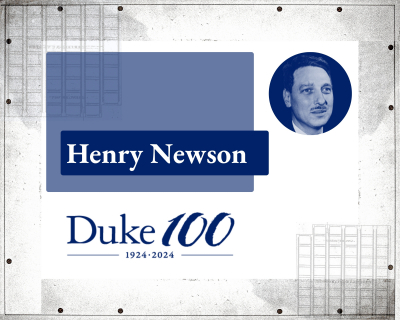Haiyan Gao, Henry W. Newson Distinguished Professor of Physics

Next November, the Triangle Universities Nuclear Laboratory will celebrate its 60th anniversary. It's among the longest running university-based nuclear physics laboratories in the U.S. and one of the most successful such laboratories in the world. I already knew of it when I was an undergraduate student at Tsinghua University in China in the 1980s because some of my professors collaborated with TUNL physicists.
We have Henry Winston Newson to thank for that legacy.
Prof. Henry Winston Newson, an accomplished physical chemist and nuclear physicist, was a leader and an institution builder who left a lasting impact on nuclear physics and the nuclear physics community. Newson and his associates at North Carolina State University and The University of North Carolina at Chapel Hill recognized the potential for amplifying their scientific impact in nuclear physics through regional collaboration. He and collaborators submitted the proposal to the United States Atomic Energy Commission that led to the beginning of TUNL: a coupled 15-MeV Tandem Van de Graaff accelerator and a 15-MeV cyclotron.
Born in Lawrence, Kansas, in 1909, Newson led an accomplished life until he passed away in 1978. Working with Nobel Prize-winning physicist Ernest Lawrence, he helped construct the cyclotron at the Lawrence Radiation Laboratory at Berkeley, participated in the first controlled nuclear chain reaction at the University of Chicago and contributed to the Manhattan Project during his time at the Los Alamos National Laboratory. But Newson is best known for his research on nuclear resonances and as one of the co-inventors of the control system used in nuclear reactors.
Newson joined the Duke Physics faculty as a full professor in 1948, then became TUNL’s founding director with its launch 17 years later. By bringing Duke, the University of North Carolina at Chapel Hill and the North Carolina State University together into a research consortium — joined by North Carolina Central University in 2018 — Newson laid the groundwork for an institution that has since become a U.S. Department of Energy Center of Excellence for nuclear research.
During its first few decades, TUNL’s researchers mostly conducted experiments using their own facilities. Newson himself was key: He was the first to combine the two kinds of accelerators TUNL acquired with its initial funding into the so-called Cyclo-Graaff configuration. By accelerating ions in the cyclotron first, then injecting them in the Tandem to double their energy, Newson enabled the research on nuclear structure that was the focus of the rest of his career. Later, TUNL added additional capabilities, like polarized proton, deuteron and neutron beams, as well as polarized targets.
In more recent decades, TUNL researchers have begun conducting and leading experiments at other facilities. Working at institutions around the world, they study fundamental symmetries and neutrinos, quantum chromodynamics, the quantum chromodynamic structure of nucleons and nuclei, as well as nuclear structure and nuclear astrophysics.
But the on-site facility Newson launched hasn’t stopped growing. Besides the original Tandem Laboratory, TUNL has added two new facilities which house different types of accelerators: the High Intensity Gamma-ray Source (HIgS) and the Laboratory for Experimental Nuclear Astrophysics (LENA).
HIgS is a unique facility in the world. It produces gamma-rays by using a process called Compton backscattering. The mechanism produces an intense beam of high-energy photons with a high degree of polarization and very precise energy, which can be tuned over a wide energy range, an important feature for experiments studying quantum chromodynamics, nucleon and nuclear structure, as well as nuclear astrophysics.
LENA is a world-class center for experimental research of nuclear reactions playing an important role in the evolution of stars and the origin of the elements. At the heart of LENA is the electron-cyclotron resonance (ECR) accelerator, producing the world’s most intense proton beams for low energy. A new, state-of-the-art singletron accelerator — designed and constructed specifically for LENA — was also brought into operation recently. In addition to fundamental nuclear physics research, these machines allow TUNL researchers to conduct applied research in areas as varied as national nuclear security, homeland security and plant biology.
More important than all the world-class equipment are the people who make TUNL a vibrant center of excellence. The laboratory has produced about 10% of all the Ph.D.’s in experimental nuclear physics in the U.S. Historically, these graduates have moved into positions in universities, national laboratories and industries, making important contributions to nuclear physics research, education, nuclear energy, medicine, national security and many other sectors. Notable TUNL alumni include former White House science advisors George A. Keyworth II and John H. Gibbons.
Professor Henry W. Newson’s legacy lives on, and I am honored to hold the distinguished professor title in his memory.
Special thanks to Ying Wu, Robert Janssens, Calvin Howell and Art Champagne for help fact checking this article.